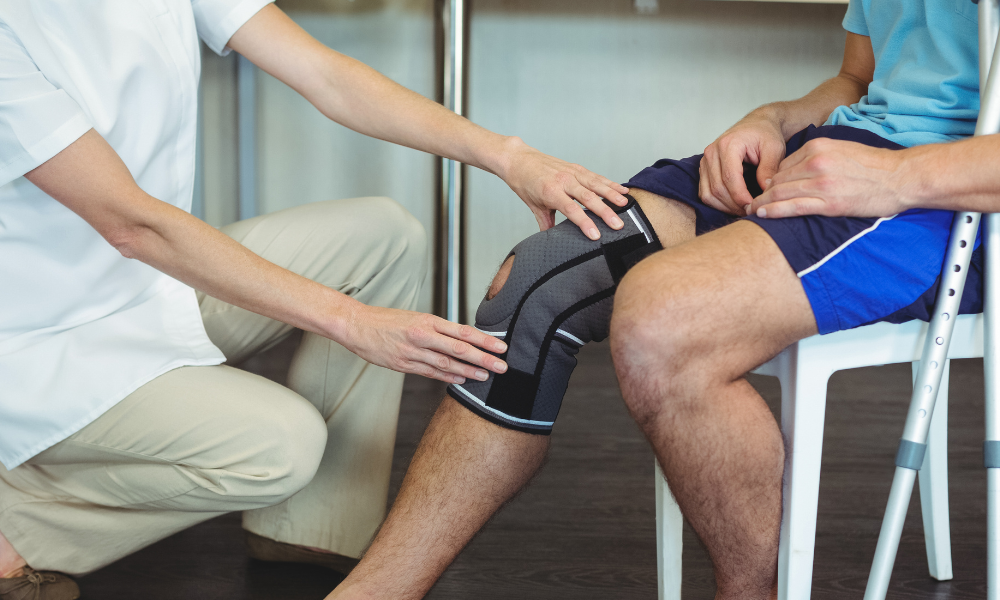Knee Surgery Recovery
Move Better. Live Fuller. Your Wellness Journey Starts Here.
Schedule a FREE Discovery Call!
About Knee Surgery
The knees are one of the most important joints in your body, and they play a vital role in mobility throughout your life. They make walking, running, climbing, jumping, standing, and balancing possible. They support your weight and keep your body stable throughout movement.
With so many functions and actions performed by the knees day in and day out, they commonly experience deterioration or injury. The knees are composed of bone, cartilage, ligaments, muscles, and nerves; therefore, various dysfunctions or knee conditions can occur. Sometimes, injuries or conditions can lead to the need for surgery.
As the knees become worn over time with natural aging and usage—or in other cases, after injury from sports or accidents—an individual may experience the following symptoms:
- Pain with movement
- Inflammation
- Grinding, clicking, or popping sounds
- Stiffness
- Swelling
- Difficulty climbing, getting up from sitting positions, or walking

There are many reasons someone may experience knee pain and other troubles. Some common knee injuries or conditions that could lead to the need for surgery include:
- Arthritis, osteoarthritis: One of the most common conditions that leads to knee surgery is arthritis, which can cause pain and inflammation of the joints. In the case of osteoarthritis, the cartilage in the joint wears down.
- Tendonitis: Inflammation or irritation of a tendon can create swelling and pain. Tendonitis is often caused by repetitive movements.
- Bursitis: This is inflammation of the fluid-filled sacs (bursae) that cushion the joints, tendons, ligaments, and skin. It can be caused by a direct injury to the knee or slowly over time with jobs or activities that require frequent kneeling.
- Ligament tears to one or all of the following: Anterior Cruciate Ligament (ACL), Medial Collateral Ligament (MCL), or Lateral Collateral Cigament (LCL). These tears are commonly caused by sudden impact or injury and can create pain, swelling, instability, popping sounds, and difficulty with bending, straightening, or twisting at the knee. These types of tears are common with sports injuries.
- Falls or accidents: Experiencing a fall or accident can create a direct impact to the knee, causing damage such as bruising, dislocation, torn ligaments, or fractures.
- Meniscus injury: A tear or damage to the cartilage that cushions and stabilizes the knee joint.
Types of Knee Surgery
In some situations, it may be necessary to utilize surgery to restore the knee’s function and to alleviate pain. Treatment will vary from case to case, but when pain becomes severe, mobility is very limited, or other treatments fail to offer relief, surgery may be suggested. Some common types of knee surgery include the following:
- Knee arthroscopy: A minimally invasive procedure that allows the surgeon to better identify possible issues in the knee. It is a common procedure, especially for sports injuries.
- Ligament reconstruction: Ligament tears are common injuries. During reconstruction surgeries, the ligament will be repaired or recreated using grafts from other tissues.
- Osteotomy: This procedure involves cutting the bones of the knee to either realign or reshape them. This can be necessary for deformed joints, damaged bones, misaligned joints, and more.
- Partial knee replacement: The knee is made up of three main bones. This type of knee replacement is suitable for patients who have only one or two areas of the knee that are damaged, such as a younger patient who has experienced an injury. These areas will be replaced with artificial structures.
- Total knee replacement: The most common type of knee replacement, where all three areas of the joint are replaced with artificial parts. Although knee replacement may sound like an intimidating procedure, it is actually a very common type of surgery.
- Meniscus repair or meniscectomy: A procedure that stitches together, removes or trims a torn meniscus to restore knee function, reduce pain and promote healing.
- Patellar realignment: A surgery that helps to adjust the position of the kneecap to correct the misalignment, alleviate pain, and improve joint function.
- Synovectomy: This procedure removes inflamed or damaged synovial tissue from the knee joint.
What to Expect After Knee Surgery
Knee surgery will take quite some time to heal. However, physical therapy is an immediate and essential aspect of knee surgery recovery that you will experience from start to end! Below, we’ve outlined how physical therapy is incorporated throughout each phase of the healing journey.
Immediately Post Operation
Although you will be expected to move again during the first week after surgery, your knee will not be able to handle your usual level of activity. During this time, you may experience some level of pain, swelling, and bruising.
In terms of mobility, you will utilize the aid of crutches or a walker. You will start physical therapy immediately, with small and simple exercises to lightly incorporate mobility into each day. While this may seem rather soon, practicing these exercises and incorporating mobility early will strengthen your knee and provide better mobility long-term.
This early period of physical therapy is essential to regaining your range of motion, normalizing your gait, and improving your ability to bend and unbend your knee. It is possible to overdo it, so be sure to follow the guidance of your surgeon and physical therapist to prevent more pain or complications.
Early Recovery Phase
During the first few weeks following your surgery, your physical therapy treatment will focus on strengthening, improving range of motion, and slowly walking again with the support of walking aids. Walking aids such as crutches are utilized anywhere from 3 to 6 weeks after surgery, but can vary depending on your rate of healing and your provider’s instruction. It is important to practice walking often, as sitting or resting for too long can result in knee stiffness.
This period of recovery will improve your knee’s mobility and strength, and you may notice a gradual decrease in swelling and pain as the weeks go by. Over time, as your ability to walk and handle your body’s weight on your “new” knee improves, you may begin to utilize a cane instead of crutches, and eventually move on to walking without a supportive aid.
Mid-to-Late Recovery
As months begin to pass, you will no longer need walking aids and will increase the amount you walk and move. Many patients are even able to drive again at the 6 to 8 week range. Depending on the level of activity your job requires, you may be able to slowly return to work.
Once you reach the 10 to 12 week mark, you may begin other activities that are recommended by your physical therapist that can improve the health of your knee—such as longer walks, more specific exercises, or even activities like swimming or cycling.
Alongside your progress, your physical therapist will alter and curate your care plan around your unique needs, which will allow you to return to your normal, individualized activities (career, sports, hobbies). They will continue to strengthen the muscles around your knee, as well as improve flexibility and range of motion.
Around the six-month mark, you should have regained a lot of function and mobility to your knee, and should be able to perform most activities. Your physical therapist should now be teaching you more difficult exercises that will improve stability and flexibility of your knee.
Long-Term Recovery
For long term success of your surgery, your physical therapist will continue to monitor the health and function of your knee. They will continue to help you understand proper form and posture that will reduce irritation or future damage to your knee. This may include recommendations about avoiding certain repetitive movements or activities that could worsen your condition.
Those who undergo knee surgery are more likely to experience problems in the future, so it is very beneficial to keep routine checks with your physical therapist to maintain the health of your knee.
Even after the first year, your knee will continue to improve. In order to support proper health of your knee, it is important to incorporate regular exercise and follow the recommendations given by your surgeon and physical therapist.
Physical Therapy for Knee Surgery
Physical therapy is extremely beneficial for the knees in many ways—in fact, utilizing physical therapy can often prevent or push back the need for surgery. However, in cases where surgery is deemed necessary, physical therapy will be necessary both before and after your surgery. Getting physical therapy treatment after surgery seems obvious, but did you know working with a physical therapist before your surgery can help, too? Let’s talk about why engaging in therapy during both times is important:
Pre-Surgery Preparation
Some may be surprised to learn that physical therapy before a surgery is just as important as post-surgical physical therapy! That is especially so with a surgery that will affect your ability to walk for some time, such as knee surgery. By engaging in physical therapy beforehand, you can prepare your body for the healing period and improve your recovery experience overall.
This includes improving your overall health and fitness beforehand, as well as preparing the muscles around your knee. Preparing these muscles will benefit the healing period, allowing a smoother and perhaps an even quicker recovery for your knee. Your physical therapist may also work on strengthening your lower body overall, so that you will have a much easier time utilizing walking aids (such as crutches) and will feel less fatigue from putting more weight on one side of your body during recovery.
Speaking of walking aids, your physical therapist can teach you how to use these before your surgery, so that the learning period isn’t immediately after your operation. While walking aids may look easy to use, they may surprise you—your physical therapist will help you understand proper form and usage of these tools to avoid associated pain and improper posture.
Post-Surgery Recovery
Physical therapy after surgery is incredibly important, and is essential for properly restoring the function of your knee. In addition to restoring function, physical therapy also provides the following benefits for knee surgery recovery:
- Pain management: Pain is expected after surgery. Your physical therapist can assist with this by using safe treatments that follow your surgeon’s care instructions.
- Flexibility and range of motion: Post-operative physical therapy will ensure your knee regains necessary flexibility and range of motion again, preventing stiffness or difficult mobility.
- Strengthening: After surgery, your muscles will be weakened and may be difficult to use. Your physical therapist will be able to create a personalized exercise plan to allow you to regain strength in your muscles.
- Activity modification: While movement and light exercise is beneficial after surgery, it is possible to overdo it. To prevent harm during this important period of recovery, your physical therapist will modify your activities as needed.
- Scar management: Scarring after a surgery is expected. By utilizing treatments such as manual therapy, your physical therapist can manage the appearance of your scar.
Our physical therapists at Hive Therapy and Wellness can address knee pain and assist with knee surgery recovery! Some common treatments used in these cases include the following:
- Neuromuscular re-education
- Manual therapy
- Exercise prescription
- Dry needling
- Cupping
- Tissue scraping
- Behavioral modifications
- Therapeutic activities
- Electrical muscle stimulation
- Spinal manipulation
- Therapeutic modalities
- Biofeedback
The knees are one of the most important joints in your body, and they play a vital role in mobility throughout your life. They make walking, running, climbing, jumping, standing, and balancing possible. They support your weight and keep your body stable throughout movement.
With so many functions and actions performed by the knees day in and day out, they commonly experience deterioration or injury.
The knees are composed of bone, cartilage, ligaments, muscles, and nerves; therefore, various dysfunctions or knee conditions can occur. Sometimes, injuries or conditions can lead to the need for surgery.
As the knees become worn over time with natural aging and usage—or in other cases, after injury from sports or accidents—an individual may experience the following symptoms:
- Pain with movement
- Inflammation
- Grinding, clicking, or popping sounds
- Stiffness
- Swelling
- Difficulty climbing, getting up from sitting positions, or walking
There are many reasons someone may experience knee pain and other troubles. Some common knee injuries or conditions that could lead to the need for surgery include:
- Arthritis, osteoarthritis: One of the most common conditions that leads to knee surgery is arthritis, which can cause pain and inflammation of the joints. In the case of osteoarthritis, the cartilage in the joint wears down.
- Tendonitis: Inflammation or irritation of a tendon can create swelling and pain. Tendonitis is often caused by repetitive movements.
- Bursitis: This is inflammation of the fluid-filled sacs (bursae) that cushion the joints, tendons, ligaments, and skin. It can be caused by a direct injury to the knee or slowly over time with jobs or activities that require frequent kneeling.
- Ligament tears to one or all of the following: Anterior Cruciate Ligament (ACL), Medial Collateral Ligament (MCL), or Lateral Collateral Cigament (LCL). These tears are commonly caused by sudden impact or injury and can create pain, swelling, instability, popping sounds, and difficulty with bending, straightening, or twisting at the knee. These types of tears are common with sports injuries.
- Falls or accidents: Experiencing a fall or accident can create a direct impact to the knee, causing damage such as bruising, dislocation, torn ligaments, or fractures.
- Meniscus injury: A tear or damage to the cartilage that cushions and stabilizes the knee joint.
Types of Knee Surgery
In some situations, it may be necessary to utilize surgery to restore the knee’s function and to alleviate pain. Treatment will vary from case to case, but when pain becomes severe, mobility is very limited, or other treatments fail to offer relief, surgery may be suggested. Some common types of knee surgery include the following:
- Knee arthroscopy: A minimally invasive procedure that allows the surgeon to better identify possible issues in the knee. It is a common procedure, especially for sports injuries.
- Ligament reconstruction: Ligament tears are common injuries. During reconstruction surgeries, the ligament will be repaired or recreated using grafts from other tissues.
- Osteotomy: This procedure involves cutting the bones of the knee to either realign or reshape them. This can be necessary for deformed joints, damaged bones, misaligned joints, and more.
- Partial knee replacement: The knee is made up of three main bones. This type of knee replacement is suitable for patients who have only one or two areas of the knee that are damaged, such as a younger patient who has experienced an injury. These areas will be replaced with artificial structures.
- Total knee replacement: The most common type of knee replacement, where all three areas of the joint are replaced with artificial parts. Although knee replacement may sound like an intimidating procedure, it is actually a very common type of surgery.
- Meniscus repair or meniscectomy: A procedure that stitches together, removes or trims a torn meniscus to restore knee function, reduce pain and promote healing.
- Patellar realignment: A surgery that helps to adjust the position of the kneecap to correct the misalignment, alleviate pain, and improve joint function.
- Synovectomy: This procedure removes inflamed or damaged synovial tissue from the knee joint.
Knee surgery will take quite some time to heal. However, physical therapy is an immediate and essential aspect of knee surgery recovery that you will experience from start to end! Below, we’ve outlined how physical therapy is incorporated throughout each phase of the healing journey.
Immediately Post Operation
Although you will be expected to move again during the first week after surgery, your knee will not be able to handle your usual level of activity. During this time, you may experience some level of pain, swelling, and bruising.
In terms of mobility, you will utilize the aid of crutches or a walker. You will start physical therapy immediately, with small and simple exercises to lightly incorporate mobility into each day. While this may seem rather soon, practicing these exercises and incorporating mobility early will strengthen your knee and provide better mobility long-term.
This early period of physical therapy is essential to regaining your range of motion, normalizing your gait, and improving your ability to bend and unbend your knee.
It is possible to overdo it, so be sure to follow the guidance of your surgeon and physical therapist to prevent more pain or complications.
Early Recovery Phase
During the first few weeks following your surgery, your physical therapy treatment will focus on strengthening, improving range of motion, and slowly walking again with the support of walking aids.
Walking aids such as crutches are utilized anywhere from 3 to 6 weeks after surgery, but can vary depending on your rate of healing and your provider’s instruction. It is important to practice walking often, as sitting or resting for too long can result in knee stiffness.
This period of recovery will improve your knee’s mobility and strength, and you may notice a gradual decrease in swelling and pain as the weeks go by.
Over time, as your ability to walk and handle your body’s weight on your “new” knee improves, you may begin to utilize a cane instead of crutches, and eventually move on to walking without a supportive aid.
Mid-to-Late Recovery
As months begin to pass, you will no longer need walking aids and will increase the amount you walk and move. Many patients are even able to drive again at the 6 to 8 week range. Depending on the level of activity your job requires, you may be able to slowly return to work.
Once you reach the 10 to 12 week mark, you may begin other activities that are recommended by your physical therapist that can improve the health of your knee—such as longer walks, more specific exercises, or even activities like swimming or cycling.
Alongside your progress, your physical therapist will alter and curate your care plan around your unique needs, which will allow you to return to your normal, individualized activities (career, sports, hobbies).
They will continue to strengthen the muscles around your knee, as well as improve flexibility and range of motion.
Around the six-month mark, you should have regained a lot of function and mobility to your knee, and should be able to perform most activities. Your physical therapist should now be teaching you more difficult exercises that will improve stability and flexibility of your knee.
Long-Term Recovery
For long term success of your surgery, your physical therapist will continue to monitor the health and function of your knee. They will continue to help you understand proper form and posture that will reduce irritation or future damage to your knee.
This may include recommendations about avoiding certain repetitive movements or activities that could worsen your condition.
Those who undergo knee surgery are more likely to experience problems in the future, so it is very beneficial to keep routine checks with your physical therapist to maintain the health of your knee.
Even after the first year, your knee will continue to improve. In order to support proper health of your knee, it is important to incorporate regular exercise and follow the recommendations given by your surgeon and physical therapist.
Physical therapy is extremely beneficial for the knees in many ways—in fact, utilizing physical therapy can often prevent or push back the need for surgery. However, in cases where surgery is deemed necessary, physical therapy will be necessary both before and after your surgery.
Getting physical therapy treatment after surgery seems obvious, but did you know working with a physical therapist before your surgery can help, too? Let’s talk about why engaging in therapy during both times is important:
Pre-Surgery Preparation
Some may be surprised to learn that physical therapy before a surgery is just as important as post-surgical physical therapy! That is especially so with a surgery that will affect your ability to walk for some time, such as knee surgery.
By engaging in physical therapy beforehand, you can prepare your body for the healing period and improve your recovery experience overall.
This includes improving your overall health and fitness beforehand, as well as preparing the muscles around your knee. Preparing these muscles will benefit the healing period, allowing a smoother and perhaps an even quicker recovery for your knee.
Your physical therapist may also work on strengthening your lower body overall, so that you will have a much easier time utilizing walking aids (such as crutches) and will feel less fatigue from putting more weight on one side of your body during recovery.
Speaking of walking aids, your physical therapist can teach you how to use these before your surgery, so that the learning period isn’t immediately after your operation.
While walking aids may look easy to use, they may surprise you—your physical therapist will help you understand proper form and usage of these tools to avoid associated pain and improper posture.
Post-Surgery Recovery
Physical therapy after surgery is incredibly important, and is essential for properly restoring the function of your knee. In addition to restoring function, physical therapy also provides the following benefits for knee surgery recovery:
- Pain management: Pain is expected after surgery. Your physical therapist can assist with this by using safe treatments that follow your surgeon’s care instructions.
- Flexibility and range of motion: Post-operative physical therapy will ensure your knee regains necessary flexibility and range of motion again, preventing stiffness or difficult mobility.
- Strengthening: After surgery, your muscles will be weakened and may be difficult to use. Your physical therapist will be able to create a personalized exercise plan to allow you to regain strength in your muscles.
- Activity modification: While movement and light exercise is beneficial after surgery, it is possible to overdo it. To prevent harm during this important period of recovery, your physical therapist will modify your activities as needed.
- Scar management: Scarring after a surgery is expected. By utilizing treatments such as manual therapy, your physical therapist can manage the appearance of your scar.
Our physical therapists at Hive Therapy and Wellness can address knee pain and assist with knee surgery recovery! Some common treatments used in these cases include the following:
- Neuromuscular re-education
- Manual therapy
- Exercise prescription
- Dry needling
- Cupping
- Tissue scraping
- Behavioral modifications
- Therapeutic activities
- Electrical muscle stimulation
- Spinal manipulation
- Therapeutic modalities
- Biofeedback
You can learn more about these treatments on our Treatments Page.





